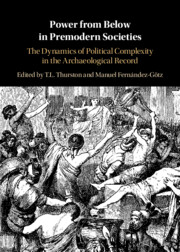 Power from Below in Premodern Societies
Power from Below in Premodern Societies Published online by Cambridge University Press: 08 October 2021
Carole Crumley’s (1979; 1995a; 1995b; 2015) explorations on the applicability of heterarchy as a concept within archaeology have been highly influential in Anglo-American discourse on social organization. Despite largely emerging from Crumley’s work on Iron Age France (Crumley, 1979), however, the relevance of heterarchy as a concept for challenging hierarchical models of European Iron Age societies has largely been restricted to Britain (e.g. Moore, 2007a; Hill, 2011), where evidence for “elites” seems most obviously lacking. Northwestern Iberia has also been a locus for discussion of acephalous and nonhierarchical social forms (Fernández-Posse & Sánchez-Palencia, 1998; González-García et al., 2011; González-Ruibal, 2012; Sastre-Prats, 2011), but one where explicit discussions of heterarchy have rarely featured. More recently, it has been argued that almost all European Iron Age societies can be regarded as “broadly heterarchical” (e.g. Bradley et al., 2015: 260), although the wider implications of this have yet to be explored. What is the place, then, of heterarchy in Iron Age studies? Has it merely become a label for all nonhierarchical models (Fernández-Götz, 2014: 36), creating various Iron Age “societies against the state” (Clastres, 1977), or does it offer ways of exploring not just alternatives to hierarchies but thicker descriptions of how all Iron Age societies worked?
To save this book to your Kindle, first ensure [email protected] is added to your Approved Personal Document E-mail List under your Personal Document Settings on the Manage Your Content and Devices page of your Amazon account. Then enter the ‘name’ part of your Kindle email address below. Find out more about saving to your Kindle.
Note you can select to save to either the @free.kindle.com or @kindle.com variations. ‘@free.kindle.com’ emails are free but can only be saved to your device when it is connected to wi-fi. ‘@kindle.com’ emails can be delivered even when you are not connected to wi-fi, but note that service fees apply.
Find out more about the Kindle Personal Document Service.
To save content items to your account, please confirm that you agree to abide by our usage policies. If this is the first time you use this feature, you will be asked to authorise Cambridge Core to connect with your account. Find out more about saving content to Dropbox.
To save content items to your account, please confirm that you agree to abide by our usage policies. If this is the first time you use this feature, you will be asked to authorise Cambridge Core to connect with your account. Find out more about saving content to Google Drive.